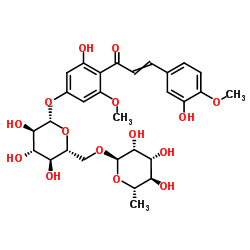Assessment of the antineoplastic potential of chalcones in animal models.
B I Roman, T S A Heugebaert, M E Bracke, C V Stevens
Index: Curr. Med. Chem. 20(2) , 186-221, (2013)
Full Text: HTML
Abstract
One part of chemical space that is endowed with interesting biological properties is the area of the chalcones. With this review, we provide a comprehensive overview of the numerous in vivo animal studies on the antineoplastic potential of both natural and synthetic members of this flavonoid subclass (covering: up to mid-2011). The thus far identified modes of action of these compounds are also discussed. We hope that this overview may stimulate deeper investigations into the biochemical mechanisms by which chalcones exert their antineoplastic action. As a result, in the foreseeable future, chalcones may prove suitable lead molecules or early drug candidates for the prevention or treatment of various neoplastic diseases.
Related Compounds
| Structure | Name/CAS No. | Molecular Formula | Articles |
|---|---|---|---|
 |
Hesperidin methylchalcone
CAS:24292-52-2 |
C29H36O15 |
|
Absorption and elimination of (14C) hesperidin methylchalcon...
1981-01-01 [Eur. J. Drug Metab. Pharmacokinet. 6(3) , 171-7, (1981)] |
|
Inhibitory effect of the Ruscus extract and of the flavonoid...
1993-08-01 [J. Cardiovasc. Pharmacol. 22(2) , 225-30, (1993)] |
|
Hesperidin, hesperidin methyl chalone and phellopterin from ...
2008-05-01 [Int. Immunopharmacol. 8(5) , 670-8, (2008)] |
|
Effect of Ruscus extract and hesperidin methylchalcone on hy...
1999-12-01 [Int. Angiol. 18(4) , 306-12, (1999)] |
|
Clinical and capillaroscopic evaluation in the treatment of ...
2007-12-01 [Int. Angiol. 26(4) , 378-84, (2007)] |